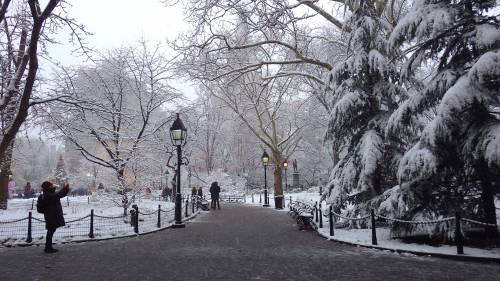By Johna Till Johnson
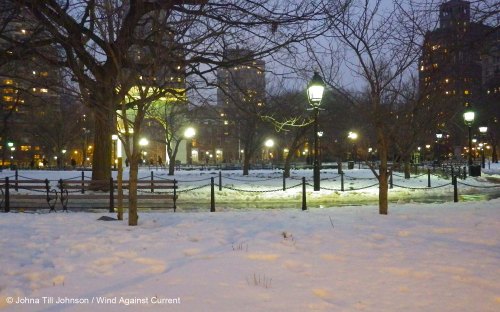
“It is so beautiful I must show you how it looks,” wrote Vincent Van Gogh in a letter to his brother. In the margin of the letter, he scribbled a quick sketch of what was so beautiful: a streetlamp at twilight.
I’ve never considered myself much of an artist. In fact, I’ve gone so far as to say I don’t understand the artistic impulse: I don’t know where it comes from, or how artists know what to create, even though I respect and admire the life-changing power of art.
But one of my favorite explanations is from a book written in 1938: “Art is a feeling of love and enthusiasm for something… in a direct, simple, passionate, and true way you try to show this beauty in things to others.”
That’s exactly what I felt walking home through Washington Square Park a few nights ago. As twilight fell, and the streetlights cast their rosy glow over the snow, the quote above popped into my head. It was so beautiful I had to share it. With Vlad’s editing assistance, I was able to capture and convey some of the magic.
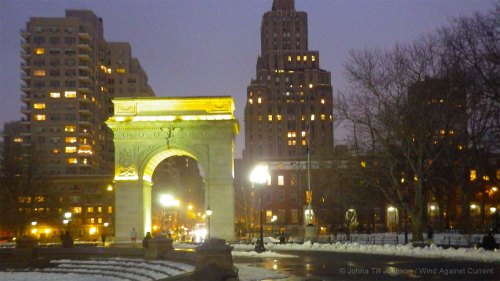
That unexpected surge of artistic sentiment made me remember how much I loved the book, and its author. The book is If You Want to Write, by Brenda Ueland.
When I first read it, many years ago, I found it inspirational, but a bit cloying. I have to admit that my perception was colored by “time bias”—that sneaking suspicion that everything in the past was quainter and less sophisticated than today. I mean, 1938? They didn’t even have iPhones! What could someone from that distant era have to say that’s meaningful about art in the 21st century?
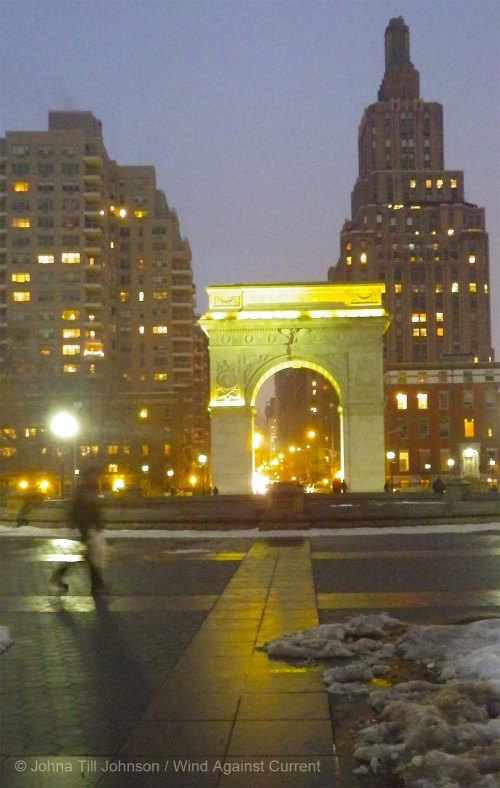
And I’ll also admit that I found the persona of the author a bit, well, twee: A little-old-lady writing teacher out in Minnesota. (Never mind that in 1938 she was a vibrant and passionate woman of 47—the photo on the book jacket was a spry, but wizened lady in 1983, so that’s how I imagined her.)
Really, weren’t all women in 1938 conventional, domestic, and limited? Not the sort of person who truly understood the bold, transformative, and terrifying power of art.
Boy, did I get that wrong! If anyone understood life, and art, it was Brenda Ueland. She lived in Greenwhich Village for many years, married, divorced (back when one “didn’t do that”), and moved back to Minnesota to raise her daughter. She supported them both with her writing, which included journalism and essays. As her Wikipedia entry says, “She lived by two rules: To tell the truth, and to not do anything she didn’t want to.”
She was a paragon of physical fitness: well into what people would call her old age, she was turning handstands, climbing mountains, and swimming long distances. (And as for that “out in Minnesota”—it’s not only intellectually vibrant but physically challenging. )
Ueland’s personal life was bold and unconventional as well. The Wikipedia entry politely notes: “By her own account, Ueland had many lovers.”
That doesn’t even begin to tell the half of it. The love of her life was Norwegian adventurer and Nobel laureate Fridtjof Nansen, with whom she had a passionate affair in the late 1920s.
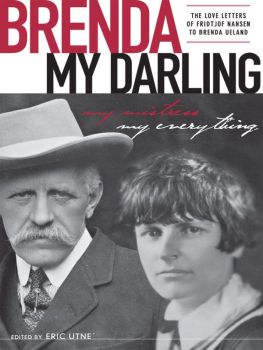 The affair came to light a few years back when Eric Utne (her grandson and the founder of the Utne Reader) published Nansen’s letters to Ueland in the form of a book called Brenda My Darling. Her letters to him have been lost, but his to her were surprisingly poetic.
The affair came to light a few years back when Eric Utne (her grandson and the founder of the Utne Reader) published Nansen’s letters to Ueland in the form of a book called Brenda My Darling. Her letters to him have been lost, but his to her were surprisingly poetic.
Nansen writes:
“Here from my window in my tower, I see the maidenly birches in their bridal veils against the dark pine wood — there is nothing like the birch in the spring. I do not exactly know why, but it is like you, to me you have the same maidenliness – and the sun is laughing, and the fjord out there is glittering, and existence is beauty!”
And that’s not all. He also sent his maiden several tasteful, but explicit, nude photographs of himself. The photographs turned the book into a minor sensation, with some—including Utne himself—questioning the decision to publish them. The deciding opinion, as Utne relates, was the Norwegian publisher of the book, Ole Rikard Høisæther, who wrote to him that “Norwegians insist on the whole truth and nothing but the truth.”
That book thoroughly exploded any delusions I’d held. Ueland was clearly no quaint, conventional lady writer—she was a strong, powerful artist in her own right. And forget the notion that age necessarily means decrepitude—Nansen was one hot guy even in his late 60s!
Moreover, though he was known for exploration and adventure, that same sentiment enabled him to write beautifully. My takeaway from all this: Art is powerful and inspiring. Showing the beauty in things can be transformative.
And as I’ve written before, there’s a strong connection between the desire to explore and the artistic sentiment: Both have life-changing power—both for the artist/explorer, and for everyone who encounters their work.
That power is available to all of us, if we only stop and listen to that inner voice calling out: “It’s so beautiful that I must show you how it looks.”

